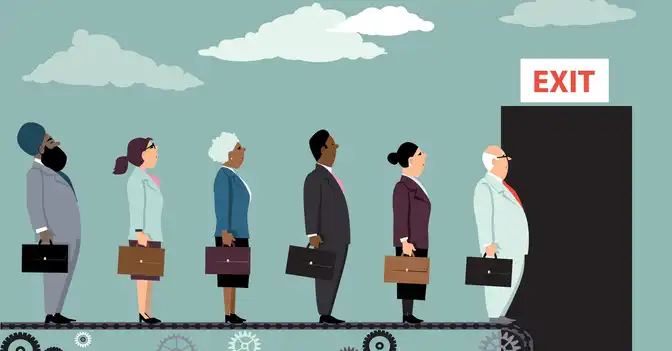The Great Resignation, a wave of mass resignations that swept across North and South America in the wake of the COVID-19 pandemic, has left a lasting impact on the workforce. While the initial surge of resignations may have subsided, the underlying factors that contributed to this phenomenon continue to influence employee expectations and behavior. To retain top talent in the Americas, organizations must adapt to these evolving trends and prioritize strategies that address employee needs and desires.
Understanding employee expectations
The Great Resignation highlighted a shift in employee priorities, with many individuals seeking greater flexibility, career development opportunities, and a focus on well-being. These expectations have become increasingly important to attracting and retaining top talent. Employees are demanding more flexibility in their work arrangements, including remote work options, flexible hours, and compressed workweeks. This reflects a desire for work-life balance and the ability to manage personal commitments. Additionally, employees are seeking organizations that invest in their professional growth and development, including opportunities for training, mentorship, and advancement within the company. Furthermore, employees are prioritizing their mental and physical health, and they expect their employers to support their well-being by offering benefits such as health insurance, mental health resources, and flexible time off policies.
Strategies for improving retention
To retain top talent in the Americas, organizations must implement strategies that address these evolving employee expectations. Offering flexible work arrangements, such as remote work options, flexible hours, or compressed workweeks, demonstrates a commitment to work-life balance and can help attract and retain top talent. Investing in employee development through training programmes, mentorship opportunities, and internal advancement pathways shows employees that their growth and career aspirations are valued. Prioritizing employee well-being by offering comprehensive benefits packages, including health insurance, mental health resources, and flexible time off policies, creates a supportive work environment that promotes mental and physical health. Maintaining open and transparent communication with employees, providing regular updates on company performance, goals, and initiatives fosters trust and engagement. Recognizing and rewarding employees for their contributions to the organization, through both formal and informal recognition, as well as competitive compensation and benefits, boosts morale and motivation. Creating opportunities for employees to connect and collaborate, both within and across teams, through social events, team-building activities, and employee resource groups, improves employee engagement and satisfaction. Fostering an inclusive and diverse workplace culture that values different perspectives and experiences helps attract and retain a wider range of talent.
By implementing these strategies, organizations can create a more attractive and supportive work environment that helps to retain top talent in the Americas. It is essential to continuously monitor employee satisfaction and adapt strategies to meet evolving needs and expectations.
Flexible work arrangements
As employees increasingly prioritize flexibility, many are seeking remote work options, flexible hours, or compressed workweeks that allow them to better manage their personal lives. This trend reflects a growing emphasis on work-life balance, with individuals expecting employers to support their need for autonomy. Offering flexibility not only improves employee satisfaction but also positions organizations as progressive and adaptable. It’s a critical element in attracting diverse talent, particularly for individuals with caregiving responsibilities or those looking to avoid burnout from rigid schedules.
Career development opportunities
Modern employees are highly focused on continuous learning and growth, seeking employers who actively invest in their professional journeys. This includes opportunities for training and certification, internal advancement, cross-departmental exposure, and mentorship programmes that offer personalized guidance. Career progression is no longer just about promotions; employees want to develop new skills that prepare them for future roles. By fostering an environment that nurtures career development, organizations send a strong message that they are committed to the long-term success and aspirations of their workforce.
Well-being initiatives
Employee well-being has taken center stage, with mental and physical health being top priorities. Beyond traditional benefits, employees expect access to mental health resources, wellness programmes, fitness stipends, and flexible time off to recharge. Providing holistic well-being support—from health insurance to therapy services—demonstrates an organization’s dedication to creating a healthier, more balanced workplace. Companies that actively encourage a culture of well-being are more likely to retain talent, as employees increasingly seek employers who value their overall health and life satisfaction.
Transparent communication
In a rapidly changing work environment, employees value clear, consistent communication from leadership. Whether through regular all-hands meetings, newsletters, or transparent updates about company performance and strategic goals, keeping employees in the loop fosters trust and loyalty. Open communication channels encourage dialogue and feedback, making employees feel heard and respected. When transparency is a priority, it leads to higher levels of engagement and alignment between staff and organizational objectives, enhancing overall productivity and morale.
Recognition and rewards
A culture of recognition is key to keeping employees motivated and engaged. Beyond salary increases, companies should explore a variety of recognition strategies, including peer-to-peer shoutouts, formal award systems, and bonuses tied to performance. Competitive compensation packages, paired with public recognition for individual and team contributions, create a sense of achievement and loyalty. Meaningful rewards, whether financial or experiential, show employees that their efforts are appreciated and inspire continued high performance.
Employee engagement initiatives
To drive a deeper sense of belonging and collaboration, organizations should implement employee engagement programmes that foster connections across teams. These initiatives might include team-building exercises, virtual or in-person social events, and the formation of employee resource groups that support diverse communities. Engaging employees in meaningful ways boosts morale and builds a sense of community, helping people feel invested in the organization’s success. When employees feel connected to both their peers and company culture, retention and job satisfaction soar.
Inclusive culture
An inclusive culture is essential for building a workforce where every employee feels respected and valued. Inclusivity goes beyond diversity; it’s about creating a safe environment where individuals of all backgrounds, experiences, and perspectives can thrive. This includes implementing equitable hiring practices, offering diversity training, and fostering open dialogue about inclusion. By championing inclusivity, companies ensure that employees feel empowered to bring their authentic selves to work, driving innovation and fostering a more dynamic, engaged workforce.
Fostering an inclusive and diverse workplace culture that values different perspectives and experiences can help attract and retain a wider range of talent. By creating a welcoming and inclusive environment, organizations can demonstrate their commitment to diversity, equity, and inclusion.
Looking forward
As we move forward, the lessons from the Great Resignation will continue to shape the workforce landscape in the Americas. Organizations must remain agile and responsive to the evolving needs and expectations of their employees. By prioritizing flexible work arrangements, career development opportunities, and well-being initiatives, companies can create a supportive and engaging work environment. Transparent communication, recognition, and fostering an inclusive culture will be key to retaining top talent. Embracing these strategies will not only help organizations navigate current challenges but also position them for long-term success in an ever-changing world. The future of work is dynamic, and those who adapt will thrive.





